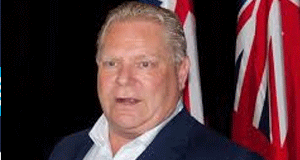This article was previously published on the Huffington Post.
The Progressive Conservatives have a new leader in Doug Ford, who says his goal is to save taxpayers money. After years of waste and mismanagement by the Kathleen Wynne and Dalton McGuinty governments, taxpayers do indeed need relief. But the question is where to start.
Here are five easy cuts to government waste that a new government could make immediately.
1. Cut the cap and trade carbon tax and the cap and trade welfare fund
The cap and trade carbon tax adds to the cost of heating your family’s home and driving to work. It also hurts businesses across the province, especially in the already vulnerable manufacturing sector where American states are courtingOntario factories with lower tax rates and taxpayer subsidies. Cap and trade will send $2.2 billion of taxpayer dollars outside of Ontario to Quebec and California by 2030, while failing to make a measurable impact on the world’s climate.
Meanwhile, the government is using that money not to give hardworking Ontarians tax relief. Instead, they’ve spent $1.9 billion in 2017 on green project subsidies through something called the Greenhouse Gas Reduction Account, for things including $100,000 Teslas.
A recent report on how money in this account has been spent found that $47 million was spent on the electric vehicle incentive program, $1 million was spend on the “electric vehicle discovery centre,” and $200 million was spent on school upgrades, which should otherwise be funded through the general budget. The report also found a number of projects funded by the Greenhouse Gas Reduction Account and Green Investment Fund which did not even meet the minimum threshold for funding: they were not even “reasonably likely to reduce, or support the reduction of, greenhouse gas emissions.”
2. Cut spending on government advertising
Government advertising in Ontario is the highest it has been since 2006-07. In 2016-17, the government spent $58 million of our taxpayer money telling us how great they are at spending our money. The auditor general found that a significant part of that, $17.4 million, was being used as partisan advertising. The government should cut the budget for government advertising and enact legislation that restricts when taxpayer money can be used on advertising.
3. Cut the LCBO monopoly and sell the assets
Prohibition ended decades ago, and Ontario doesn’t need to rely on the government to sell liquor to the public. Wynne recently allowed the sale of wine and beer in a select number of grocery stores, adding a layer of micromanaged political interference to something that is as straightforward as selling a consumer a product they want to buy.
Meanwhile, large and flashy LCBO stores, complete with test kitchens, tasting bars and glossy magazines cut, with unionized employees into the profits of a business that could be more efficiently operated privately. Private stores would also improve consumer choice; after liquor stores were privatized in Alberta, product selection increased from 2,200 varieties to more than 20,000 now. Selling off the LCBO and ending the monopoly on beer, wine and liquor would improve consumer choice, provide a shot of revenue to the government and get government out of a business they shouldn’t be in.
4. Cut the Wynne experiment in basic income
The Wynne government is spending $50 million per year on a new welfare experiment handing out free taxpayer money. They call it the “basic income project,” and the project gives up to $17,000 for low-income individuals and $24,000 for couples. The money is given no-strings-attached to 4,000 low-income individuals or households, and the benefit is reduced as the recipient earns income. Paying some people tens of thousands of dollars not to work while continuing to increase taxes for the rest of us makes no sense. There is no corresponding reduction in other welfare entitlements. This crazy experiment needs to be shelved and forgotten.
5. Cut the size of government with a hiring and wage freeze
The number of government employees in Ontario has grown dramatically in the past 20 years. Since 1997, there are 43 per cent more bureaucrats, which is faster than private-sector job growth and self-employed job growth. Government employees in Canada have seen an average wage growth of over 26 per cent since 1997, second only to those in the mining industry. It’s true that Canada has been fortunate with a resource boom. But that does not justify a corresponding government boom. Government employees are also paid an average of 13.4 per cent more than private-sector workers for similar work, in addition to non-wage benefits. We need to cut the size of government, starting with a wage and hiring freeze, and allow natural attrition to occur.
This year, the Ontario government ran a $6.7 billion deficit, despite recommitting in November to a balanced budget this fiscal year. These five suggestions are just a start — the government also wastes billions on corporate welfare and unnecessary renewable energy contracts. Taking these first steps is necessary if the Ontario government is going to start to dig out of this hole.
— Christine Van Geyn
 TheBulletin.ca Journal of Downtown Toronto
TheBulletin.ca Journal of Downtown Toronto

